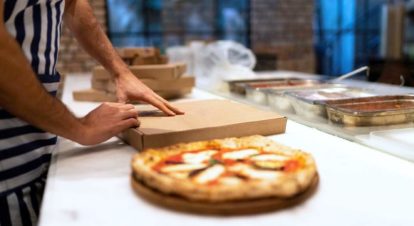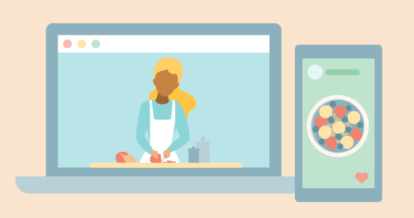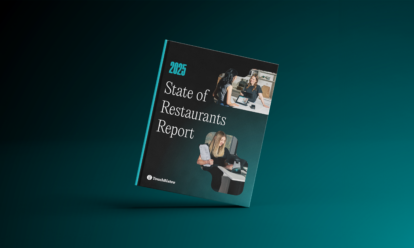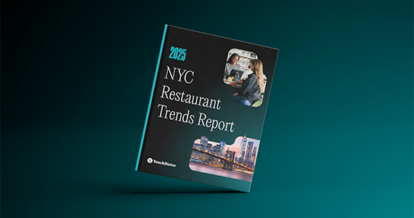In the UK and around the world, the spread of COVID-19 forced restaurants to close their dining rooms and quickly pivot to takeaway and delivery. And with this unprecedented shift to delivery-only dining, restaurateurs quickly became familiar with a new term: no-contact delivery.
A radical departure from the hospitality industry’s signature “service with a smile” mentality, no-contact delivery is uncharted territory for restaurants. But with growing pressure to flatten the curve, no-contact delivery may be the only way for restaurants to keep the public safe, while making enough money to cover their costs, pay their staff, and ride out this storm.
Whether you’ve chosen to implement contactless delivery or are still considering it, we’ve got the tools you need to implement no-contact delivery at your restaurant.
In this post you’ll learn:
- What is no-contact delivery
- Why you should implement contactless delivery
- Examples of how restaurants are implementing no-contact delivery
- How to successfully facilitate contactless delivery in your own restaurant
What Is No-Contact Delivery?
No-contact delivery – or contactless delivery – simply means that delivery staff leave a food order at the customer’s doorstep, lobby, or another safe place, rather than ringing the bell or knocking on the door, and having the food change hands directly. The customer is notified by phone, text, or email that the order is ready for collection, which they can do at their convenience (usually, just by opening the door).
In order to facilitate no-contact delivery, payment must be made over the phone, through a website, or a third-party app, since the delivery person will not be interacting directly with the customer to take payment.
Why Implement No-Contact Delivery?
COVID-19 spreads mainly through person-to-person transmission. As a result, the NHS and health officials are encouraging a variety of measures to help slow the spread of the virus. These measures include regular hand washing, social isolation if they have the virus or live with someone who has symptoms of the virus, and social distancing.
For restaurateurs like yourself, no-contact delivery is one way of encouraging social distancing and preventing the transmission of the virus. By implementing contactless delivery, you play your part in flattening the curve so that the NHS doesn’t become overwhelmed – and business can get back to normal sooner.
How Restaurants Are Implementing No-Contact Delivery
Many restaurants have implemented no-contact delivery across the UK. One of the many examples is Bistro Union, in Clapham.
From March 23rd, the restaurant converted into a community shop, offering freshly-cooked meals, handmade pasta, dried goods, and wine, among other essentials. On the company website, the owners announced they offer free local and contactless delivery for the elderly and vulnerable.
Third-party delivery apps in the U.S. and Europe have also been quick to implement no-contact delivery. For instance, Deliveroo, DoorDash (which owns Caviar), Postmates, and Uber Eats all give customers the option to specify no-contact delivery when placing their order. These companies have also doubled down on other health and safety measures, such as providing delivery drivers with antibacterial hand sanitiser, and adding additional packaging and tamper-evident stickers to delivery bags.
5 Ways to Facilitate No-Contact Delivery
It’s clear that customers are not only demanding no-contact delivery as a way to assuage their fears over the spread of COVID-19, but also that restaurants must take every step possible to protect the health and safety of the general public.
But with this being a virtually brand new service, it can be difficult to know how to implement it in your restaurants. To help you set up no-contact delivery, we’ll walk you through the process.
1. Get the Right Equipment
If you don’t have delivery already in place, you have the option of setting up your own delivery system or partnering with a third-party delivery app. While using delivery apps come with some major benefits, it may take days or weeks to get your restaurant set up with a new platform – especially with the onslaught of restaurants switching to delivery right now.
If you do decide to set up your own delivery system, you’ll need to start by making sure you have all the proper equipment to facilitate no-contact delivery.
Access to a Car (or Bike)
It goes without saying that you can’t deliver orders if you don’t have some type of transportation. If you’re setting up your own delivery system, you’ll need to determine which employees are able to use their personal vehicles for deliveries. In some cases this may be a good opportunity to keep FOH staff on the payroll, by shifting their responsibilities to facilitating deliveries.
Commercial Auto Insurance
Drivers making food deliveries without commercial car insurance are essentially treated as if they have no insurance – even if they have personal insurance coverage. Therefore, any driver using their personal vehicle for food delivery will need to notify their insurance provider and switch over to a commercial vehicle policy that has food delivery insurance. In some cases, your insurer may offer supplemental coverage to a personal policy or special policies designed for delivery persons.
Warming Bags
Even if a delivery is around the corner, you still need to make sure that the food you’re sending out stays fresh and warm. To do this, you’ll need warming bags, as well as sturdy, temperature-controlled takeaway containers for your food.
Car Signage
With no-contact delivery, there is no interaction between the customer and the delivery driver. To help customers identify delivery drivers from a distance, make sure to outfit your cars (or bikes) with your logo or the name of your restaurant.
Payment Processing Equipment
One of the challenges of no-contact delivery is that customers will not be able to pay for their order at the door. In this case, you’ll need to secure payment processing technology that allows for card not present transactions and tips. This will allow customers to pre-pay for their orders (over the phone or through a website) and eliminate the need for in-person transactions.
2. Train Your Staff
One of the biggest challenges of setting up no-contact delivery is training staff. On the one hand, you will need to take extra precautions when it comes to food safety and employee hygiene. But on the other hand, you will also need to create new workflows for taking orders, preparing food for delivery, and facilitating no-contact deliveries.
Whether you’re using a third-party ordering system or not, here are some training measures to keep in mind when offering no-contact delivery.
Taking Orders
If you’re not using online ordering apps, the phone is the most efficient way to take delivery orders. To keep things organised, you’ll want to train a dedicated employee on how to receive delivery orders and expedite food. Ensure that the employee talking orders clarifies with the customer where the food will be dropped off – whether that’s at a doorstep, the lobby of an apartment building, or another location.
Keep in mind that with no-contact delivery, there is no option for the customer to pay in-person. As a result, you will need to train employees taking orders to also collect payments over the phone by using payment processing technology that allows for card-not-present transactions.
Packaging
With health and hygiene a top concern right now, it’s important to train employees on how to safely package food for delivery. In addition to reinforcing existing food safety and personal hygiene procedures, take extra precautions to ensure cleanliness when packaging food. Extra precautions can include:
- Implementing pre-shift employee screenings
- Keeping employees separated by at least six feet
- Increased sanitisation of high-touch, high-traffic areas
- Using fresh gloves for each order
- Elevated frequency of personal hygiene requirements, including handwashing
- The use of tamper evident packaging (a label or seal that provides visible evidence if a product has been tampered with)
Beyond enhanced safety measures, you’ll also need to dedicate a specific employee to packaging each order. This “delivery specialist” should be responsible for folding any takeaway containers, setting up the packaging station, and preparing to-go bags with all the necessary sauces, utensils, and napkins.
Delivery
On the Gov.uk website, it states that “it is very unlikely that you can catch coronavirus from food. COVID-19 is a respiratory illness. It is not known to be transmitted by exposure to food or food packaging.”
However, there is a concern about person-to-person contact via delivery. Therefore, it’s vital to properly train staff on how to safety execute a no-contact delivery.
Whether you’re using third-party delivery drivers or not, make sure there is a dedicated area for delivery drivers to pick up food. This can be outside the restaurant or in another area far from the kitchen staff who are preparing food. Make sure delivery drivers are washing their hands prior to picking up each order and frequently sanitising their vehicles with antibacterial wipes.
Drivers should then be instructed to drop off the order at the dedicated spot and notify the customer that the order is ready for collection. There should be no direct contact with the customer and drivers should be using hand sanitiser or washing their hands following the delivery of each order.
In addition to easing customer’s fears, implementing these extra safety precautions also shows your staff they’re supported by you. It’s a scary time to be going to work for everybody, so having practices in place to protect diners and staff through no-contact delivery is another way to show your staff you are actively looking out for their well-being.
3. Set Up or Optimise Online Ordering
While you can certainly take all your no-contact delivery orders over the phone, online ordering allows you to streamline the process, take more orders, and stay organised. Online ordering also lets customers pay for their order online, which is essential for no-contact delivery.
Third-Party Online Ordering Apps
To set up online ordering, you can choose to use a third-party app such as Deliveroo, Uber Eats, or JustEat. These platforms allow you to upload your menu so that customers can build and pay for their order online. They also give customers the option to add specific instructions for delivery drivers about where to leave delivery orders for no-contact delivery.
These apps manage the delivery process for a fee, but because of the unique and tough situation we all find ourselves in, many food delivery services have agreed on discounted rates. Deliveroo still takes commission on sales, but it has dropped its joining fees, encouraging thousands of new restaurants to come onboard. Also, Uber Eats announced they’ll waive delivery fees for all orders from independently owned restaurants until March 31st, at which point it will be reviewed.
In-House Online Ordering
If you’re looking to cut out the middle man, you also have the option to add online ordering to your restaurant’s existing website. The following services can be used to set up online ordering on your website:
- The Ordering.app is a Google application that allows you to accept online food orders. To help support restaurants during COVID-19, The Ordering.app is waiving its fees until July, 2020.
- Food Booking UK is an online ordering solution for restaurants. With the financial pressures COVID-19 restrictions bring to restaurants, this may be a good option since it’s free to try out. The service integrates into websites and Facebook pages, making it easy to get started with taking online orders for takeaway and delivery.
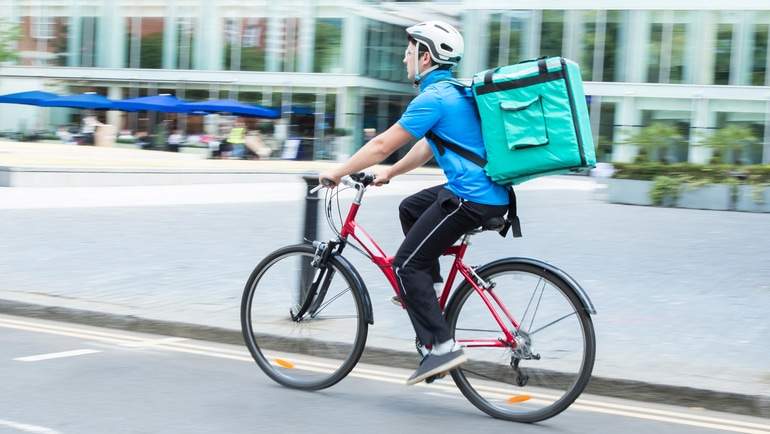
4. Update Your Menu
You’ll also need to update your online menu, on your website and any third-party platforms.
Like many other restaurateurs, you’re probably operating on limited resources and a lean workforce, so you should concentrate on creating a small menu that’s easy to execute. This may mean changing up your menu temporarily, but it’s worth it to meet customer demands while taking care of your bottom line.
There are many benefits to this. By limiting the number of menu items, your kitchen staff don’t have to run around trying to prepare a whole bunch of different recipes at once. This will help keep food costs and waste down, as well as help you limit the amount of staff you need in the kitchen so it’s easier for them to keep their distance from each other.
A smaller, simpler menu will also help your staff execute each order quickly and efficiently. This means the delivery person can drop off more orders, faster, which will hopefully help keep customers happy and returning.
Also, by sticking to simpler dishes, you ensure your menu is optimised for portability and quick delivery – imagine how many hands are needed to prepare and deliver a complicated beef wellington with leek reduction versus mac and cheese. Make dishes that are easy to transport and use spill-proof packaging. No-contact delivery means leaving a package out on somebody’s doorstep, so the sturdier, the better.
5. Communicate with Customers
Because you have a community of customers who care about you and want to support you, it’s important that you communicate with them.
Let customers know you will be offering no-contact delivery in response to the COVID-19 outbreak, as a way to help slow the spread and keep everybody safe.
After you’ve told them what you’re doing, tell them why – make sure your customers know your change in operations is all to help them stay healthy. No-contact delivery may be a new experience for your guests, but are only being put in place to protect them while still allowing them to enjoy your food.
You can communicate this message across a variety of platforms. For example:
- Post an update on your website about the new practices
- Email customers if you have an email list
- Post updates on social media, both your own channels or local community groups you’re part of
- Include signs in the front of your restaurant such as on your doors
- Update your messaging on third-party delivery sites, like Uber Eats, Deliveroo, and JustEat.
We All Have to Play Our Part
With the COVID-19 outbreak causing restaurants to adjust their business models, many are shifting to focus on no-contact delivery as their main revenue source. If you make sure to set up your new operations, train staff, and communicate with guests, you can transition into this new model as smoothly as possible.
As you navigate this tough time, remember that you are not alone. We are all in this together and need to help one another – so please reach out if there’s any resources we can provide that will help you navigate this. Email us at [email protected], or check out our other COVID-19 resources here.
Sign up for our free weekly TouchBistro Newsletter

